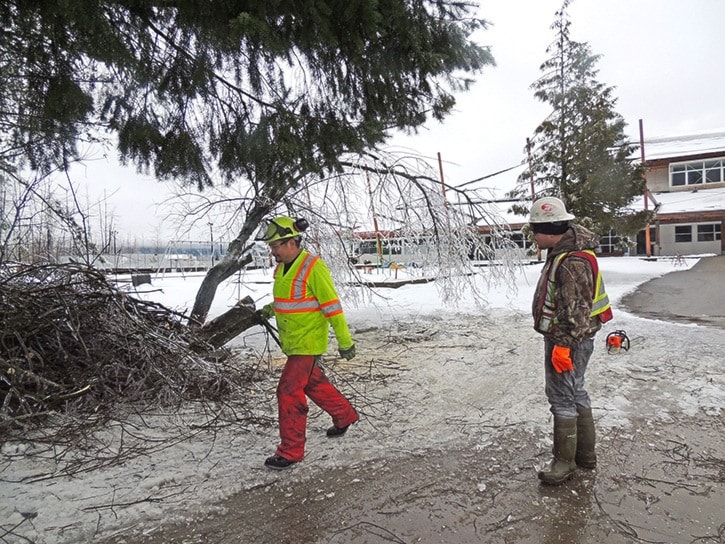Mother Nature wreaked havoc on the entire eastern Fraser Valley this week, hitting the District of Kent, Harrison Hot Springs and surrounding communities particularly hard.
A beautiful snowfall Sunday turned into ice and rain, leading to heavy snow-laden trees, ice on power conduits and tree branches falling on power lines. While power outages stretched across the Lower Mainland, giant swaths of customers in this community were without power on and off throughout early Monday morning and into Tuesday. The power outages forced the shut-down of all Fraser Cascade schools. Village of Harrison Hot Springs and District of Kent crews were out Monday morning clearing the snow. But all was quiet as businesses remained closed due to the lack of power for a portion of Monday.
Crews from Stqó:ya Construction were busy at Seabird Island Monday and Tuesday clearing downed trees and hazardous branches. Seabird was without power most of Tuesday and the Seabird Island Community School was shut down all of Tuesday, even as schools in Agassiz and Harrison re-opened.
BC Hydro spokeswoman Simi Heer says the eastern Fraser Valley was definitely the “hardest hit” in the province Monday. The power outages began in the early morning and, at its peak, affected approximately 14,000 customers.
“We saw outages throughout the day,” says Heer, explaining the challenge for BC Hydro crews was that as some power grids were fixed, others failed. So the number of grids to be restored kept changing.
“The major issue with this storm was ice buildup on conduits and power lines,” Heer explains.
The weight of water-soaked snow and icy buidup on trees led to branches falling on power lines. It has been an “extensive restoration process,” says Heer.
In any outage, crews start with the largest amounts of affected customers first and work down to the smaller outages. So Heer says there is no way of guaranteeing when every grid will be restored, adding crews have been hampered by continued bad weather conditions in areas such as Hope. As of The Observer’s press time, there were still hundreds of homes, mostly in Hope, still without power. The Fraser Valley Regional District opened the Recreation Centre in Hope on Tuesday for people needing a warm place to shower, use the washrooms or stay overnight.
Meanwhile on Highway 1, the weather forced a shutdown of the eastbound lane near the Flood-Hope Road for almost 24 hours. Eastbound traffic was diverted at Highway 9 and detoured through Highway 7, bringing a massive influx of traffic through the corridor beside Agassiz. On Monday at around 12 pm, a “single huge boulder” came down from a high location above the highway, describes Amos Gutman, operations manager for Emil Anderson Construction.
“It’s a problematic area,” says Gutman. Due to the terrain beside the highway, he says if there is a rockslide between Chilliwack and Hope, that area is where it’s most likely to occur.
Emil Anderson closed the highway but crews were not able to clear the road until a geotechnical engineer assessed the stability of the slope. Usually, explains Gutman, the engineer will do a helicopter fly-over of a slide area to look for any further rock slide concerns before crews are allowed on scene to clear the road. Due to inclement weather Monday, the helicopter was not able to fly until Tuesday morning somewhere between 9 and 9:30 a.m. Crews quickly cleared the boulder and a few small rocks and all lanes of the highway were open by 11 a.m. Tuesday morning.
Gutman says the boulder was most likely dislodged due to rain and ice which added to the weight.
